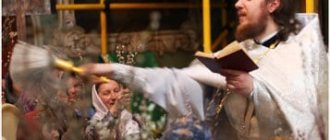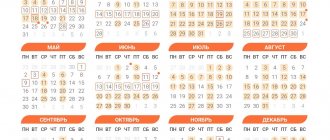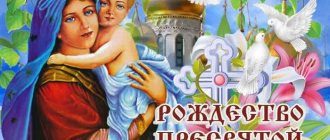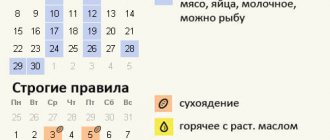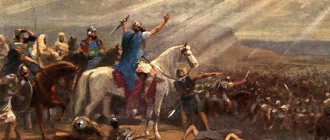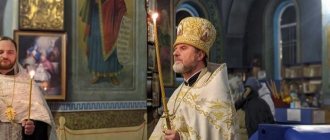What is the twelfth holiday
Judging by the consonance of the words, it is easy to guess that the name, unusual for the ears of modern people, comes from the numeral 12. In Orthodoxy, such events are considered very important. After Bright Easter Sunday, they are the most significant and revered.
Each celebration, which the Orthodox Church refers to as the Twelfth, is marked by a certain episode from the life of Christ on sinful earth and the Mother of God. In the statutory church document Typikon, these celebrations are marked with special honor: a red cross is placed over the dates. This emphasizes their great importance.
Which twelve holidays are included in the list of movable (transitionable) holidays?
3 holidays are called “movable”:
- Entry of the Lord into Jerusalem (on the Sunday preceding Easter),
- Ascension of the Lord (40th day from Easter, always on Thursday) and
- Holy Trinity Day (50th day from Easter, always on Sunday).
All twelve holidays: list with dates in order
All important and highly revered annual twelve and great holidays in Orthodoxy:
- January 7 – Great celebration of Christmas;
- January 19 – Epiphany;
- February 15 – Presentation of the Lord;
- April 7 – Annunciation;
- Palm Sunday (in Orthodoxy it is customary to celebrate 7 days before Easter Sunday);
- Ascension (celebrated on the 40th day after Easter);
- Great Day of the Holy Trinity (held on the 50th day after Easter Sunday);
- August 19 – Transfiguration of the Virgin Mary;
- August 28 – Assumption;
- September 21 – Nativity of the Virgin Mary;
- September 27 – Exaltation of the Cross;
- December 4 – Presentation of the Most Holy Heavenly Intercessor into the temple.
Which twelve holidays are included in the list of fixed (immovable) holidays?
- Nativity of the Blessed Virgin Mary (Sept. 8/21),
- Exaltation of the Holy Cross (Sept. 14/27),
- Entry into the Temple of the Blessed Virgin Mary (November 21 / December 4),
- Nativity of Christ (December 25 / January 7),
- Epiphany, or Epiphany (Jan 6/19),
- Presentation of the Lord (2/15 Feb.),
- Annunciation of the Blessed Virgin Mary (March 25/April 7),
- Transfiguration of the Lord (6/19 Aug.) and
- Dormition of the Blessed Virgin Mary (August 15/28).
How to spend the twelfth holiday
If possible, on the Great Day you need to attend a service in the temple. If this is not possible, you can send a note with the listed names of people dear to your heart so that they will be mentioned during the liturgy.
Every believer knows that holiday services always begin on the eve of the event marked in the church calendar. At night there is a break, and the continuation of the service can be observed in the early morning.
It is advisable to come to confession and receive communion the day before. This will help you become closer to higher powers and better understand the significance of the big event. In the family circle and among like-minded people, it is worth studying in more detail the history of the Christian celebration.
Fun festivities and entertainment should be abandoned. It is better to spend a great day with your family, in reflection, and reading useful literature. The holidays that belong to the twelve are of great importance for every Christian. It is believed that these days the connection with the Almighty becomes more tangible, and each person gets the opportunity to improve spiritually.
Divine service
The service for the twelve feasts of the Mother of God has the following characteristic features: an all-night vigil is celebrated, preceded by little vespers, the hymns of the Octoechos are completely canceled, unless the holiday coincides with a Sunday. The All-Night Vigil includes Great Vespers (“Blessed is the man” sung), Festive Matins and the first hour. On the 9th song of the Matins canon, the hymn of the Most Holy Theotokos (“My soul magnifies the Lord:”) is canceled, and instead of the verses of the song of the prophet. Zechariah is sung with festive choruses (Greek: Megalunaria - magnification; polyeleos magnifications are not currently used in Greek Orthodox worship). At the liturgy, figurative antiphons are sung, at the blessed ones - troparia from the canon of the holiday, but in Greek. In liturgical practice, on the twelve feasts of the Mother of God, as well as on the Lord's feasts, special holiday antiphons are sung.
On the after-celebrations of the twelve feasts of the Theotokos, the Octoechos is not sung (except on Sundays), the service of the Menaion is combined with the service of the holiday; on the days of giving at the liturgy, along with the daytime readings, the readings of the holiday are read (which does not happen on the giving of the Lord's holidays).
When the twelfth feast of the Theotokos coincides with Sunday, the services of the Octoechos and Menaion are combined, and the Sunday hymns of the Octoechos precede the hymns of the holiday, but the Sunday service loses some of its integral elements: on “Lord, I cried,” the dogmatic voice is not sung, and instead of the Sunday morning Gospel, the festive one is read. The Matins canon includes the hymn of the Most Holy Theotokos, and the festive choruses are abolished. The Gospel stichera is sung not in its usual place (on “Glory:” on khlagitekh - its place is taken by the samoglas of the holiday), but before the 1st hour. The fact that the Gospel stichera and exapostilary paraphrasing the Sunday morning Gospel, despite the abolition of the reading itself, were left in the service, is explained by the ancient practice reflected in the old printed Russian. books, when the Sunday morning Gospel reading was still read, - after the great doxology, the entrance with the Gospel was performed, one of the 2 Sunday troparions was sung as an entrance ("Today is salvation:" or "Jesus has risen from the grave:"), "Glory:" - the end of the same troparion, “And now:” is the entire troparion; This was followed by the Sunday prokeimenon and the Gospel [9]. The service of the Feast of the Annunciation, which falls during the singing of the Triodion, has a special charter (see Art. Annunciation Chapters).
General service of the Mother of God
In the General Menaion, in Chapter 2, there is a general service for the feasts of the Mother of God. It has the same composition as other services of the General Menaion: 3 cycles of stichera (on “Lord, I cried”, on the stichion and on the praises), a number of samoglans, a full body of sedals, the canon of the 8th tone (irmos: “Water passed like dry land”, beginning: “Strengthen me with God’s power in piety”), 2 kontakia (1st tone, beginning: “The honorable dwelling that was the ineffable nature of the divine,” and 6th tone, beginning: “Not other imams help") with an angle to the 1st, luminous; At the end of the book there are biblical readings for Vespers, Matins and Liturgy. The troparions of the service are taken from the prayer service (“To the Mother of God now we are diligent as priests” and “Let us never be silent, O Mother of God,” tone 4). Selected psalm: “Remember, Lord, David, and all his meekness:” (from the service of the Nativity of the Theotokos), magnification: “Let us bring every spiritual song to the Mother of God.” Dr. the books indicate as a general magnification: “It is worthy to magnify you, the Mother of God, the most honorable cherub and the most glorious without comparison seraphim”; On the feasts of the icons of the Mother of God they usually sing: “We magnify you, most holy Virgin, and honor your holy image, through which you bring healing to all who come with faith.” All the twelve feasts of the Mother of God and the Intercession have special magnifications and selected psalms; There is a special magnification of the Mother of God in the service of All Saints who have shone in the Russian land.
Bible readings for the Mother of God holidays
At Vespers on the feasts of the Theotokos, during the polyeleos or vigil service, there are 3 proverbs: Gen 28. 10–17 (which speaks of the prototype of the Mother of God - the ladder to Heaven, which Jacob saw in a dream), Eze 43. 27 – 44. 4 (the description of the closed gates, which remained closed even after the passage of God, indicates the Ever-Virginity of the Mother of God), Proverbs 9. 1–11 (reading begins with an indication of the Incarnation). Other proverbs are used on the Feast of the Introduction; In addition to the 3 indicated, the Annunciation has 2 more special proverbs for reading at festive vespers and liturgy. At the matins of the Mother of God feasts (except the Annunciation), the Gospel of Luke (1. 39–49, 56), containing the hymn of the Most Holy Theotokos, is read; some of the verses (50–55) are skipped because, firstly, they talk about the Messiah, and not about the Mother of God (unlike other verses), and secondly, this song is constantly heard during worship and it is not necessary to repeat it entirely included in this morning's Gospel. At the liturgy of the feasts of the Mother of God, the following are usually read: Phil 2. 5–11 (which tells about the incarnation of God the Word; according to most modern scholars of the New Testament, this fragment is a liturgical hymn of the apostolic times) or Heb 9. 1–7 (which talks about the Tabernacle of the Covenant - probably because the Lord dwelt in the Mother of God, as in a tabernacle), Luke 10. 38–42, 11. 27–28 (the Blessed Virgin is compared with Mary, the sister of Lazarus, “who chose the good part”; in the 11th chapter. a testimony is given about the beatitude of the Mother of Christ, as well as the believers); Prokimnas are Lk 1.40 (verse: Lk 1.41) or Ps 44.18a (verse: Ps 44.2); Alleluia verses, as a rule, are taken from Ps 44, sacramental verses - from Ps 115. 4.
In the Octoechos system, a special remembrance of the Mother of God is present in the services of Wednesday and Friday. According to Nicephorus Callistus, imp. Pulcheria established a vigil and lithium procession in honor of the Virgin Mary every Wednesday, and Patriarch Timothy I (511–518) established a procession every Friday from Blachernae to Chalcopratia; in Octoechos, stichera and canons to the Mother of God are laid out for these days, along with hymns to the Cross. On Sunday in Octoechos, along with hymns in honor of the Cross and Resurrection of Christ, stichera and a canon to the Mother of God are laid. Thus, in the weekly circle of worship, the ancient principle of the joint glorification of Christ and the Mother of God has been preserved.
Divine service for the Presentation of the Lord
The Presentation of the Lord is sometimes considered a feast of the Theotokos, both in content and in its statutory features - modern. The Typikon, if it coincides with a Sunday, does not cancel the service of the Octoechos; Candlemas does not have festive antiphons in the liturgy (in late Greek practice there are such antiphons). Often in handwritten and printed Jerusalem Typicons, the feast of the Presentation of the Lord is mentioned among the feasts of the Mother of God in the chapter on the celebration of the service of these feasts on Sunday [10]. However, the discrepancy between the service regulations and the model of the Lord’s Twelfth Feast cannot indicate that this is the Feast of the Theotokos. One can compare the special charter of this day with the charter of other non-twelfth Lord's holidays (Circumcision of the Lord on January 1, New Year's Day on September 1, Removal of the Trees of the Holy Cross on August 1, Translation of the Ubrus of the Lord on August 16), which allow connection with the Sunday service; At the Liturgy of the Presentation, as on the Lord's feasts, the entrance verse is sung. But, of course, on this day those who were related to the celebrated event are especially glorified - the Most Holy Theotokos and the Rights. Simeon the God-Receiver, mentioned, in particular, in the troparion and kontakion (the 1st is addressed to the Mother of God, and the 2nd to the Lord), in the liturgical prokeemne (song of the Mother of God) and alleluia (song of Simeon) and many others. other holiday chants.
Questions and answers
| What does the twelfth holiday mean, why is it called that? |
| Orthodox celebrations, which are included in the 12 main highly revered dates, the reason for the appearance of which were the events of the earthly life of the Son of God and the Mother of God. |
| Is Easter Sunday considered one of the main twelve holidays? |
| No, this celebration stands alone and is honored above all other Orthodox dates. |
| Is it necessary to fast during the twelfth period? |
| Some dates fall during strict fasting. For example, on the eve of Epiphany, if your health allows, you need to spend the whole day on the water. But this does not apply to all twelve. The most important thing when celebrating church celebrations is not to indulge in gluttony. |
| Why is it advisable not to attend social entertainment events? |
| This must be done so that the connection with the Lord is stronger, and then one can hope for his help in all endeavors. |
Dogmas of the Orthodox Faith
Orthodox religious traditions are based on four basic dogmas: unchangeable truths accepted on faith and determining the life of the church and all followers of the Orthodox faith.
The first dogma - Father, Son and Holy Spirit - are not three gods, but three masks of one deity, radiating universal Love.
Secondly: Jesus Christ is God who took on human flesh. When people turn to Him in prayer of thanksgiving and ask for forgiveness for all intentional and unintentional sins, He understands those praying, since He Himself has experienced all human physical and mental suffering.
Third is faith in the coming resurrection. Christ, crucified on the cross, conquered death and rose again. Orthodox Christians believe that they can be resurrected in the flesh and enter into eternal life after the Second Coming of Christ.
The fourth dogma is faith in the church. You can approach the Almighty only through the church; Attending temple services by Christians is considered a sign that God dwells in the human heart.
The traditions of the Orthodox Church involve observing fasts, repenting of sins before a priest (confession), and participating in solemn services on major religious holidays. In everyday life, Orthodox Christians adhere to the rules bequeathed by the Savior: they try to live in love and harmony. One of the components of moral purity in Orthodoxy is such a ratio of spiritual and bodily needs, when concern for daily bread does not overshadow spiritual searches. Even when preparing food, you should consult the church calendar to find out which day is fast or fast.
